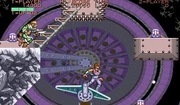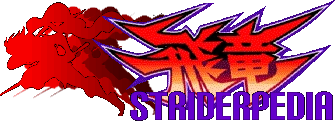Siberia (シベリア) is the second stage from the original Arcade game and all its ports. The stage's official name is Running through Siberia (シベリア走破) in Japanese[2], and Siberian Wilderness in English[3]. The intro text shown at the beginning of the stage is the Cyrillic writing for Siberia (Сибирь).
Story[]
Siberia is a large region belonging to Russia located mainly in Northern Asia. This frozen land houses one of Grandmaster Meio's secret bases[4], built inside a mountain side, as well as an abandoned power station near it used as a takeoff platform for airships[4]. This location is also where those who incur the anger of Meio or the Kazakh Federation's ruling party are sent to work forced labor as punishment, a fate that befell the Kazakh Research Staffs.[1][5]

Secret Base's Machinery Room
Following the destruction of St. Petersburg and the elimination of its whole officer council, Hiryu attempts to escape the Eurasian continent by running through Siberia[5]; moving out in order to shake off Meio's followers[6], assassins and bounty hunters seeking the reward offered for his head[1][7]. Running into a mountain-side tunnel Hiryu discovers Grandmaster Meio's secret base[5], climbs to the top of the mountain and battles the bounty hunter Solo.
Running down the side of the mountain on his way out of the area, Hiryu reaches an abandoned power plant with electric generators and is intercepted by an airship force commanded by the trio of martial artists, the Kuniang[1][5]. Ascending through the smaller Flying Tortoises, Hiryu reaches the main ship, the Sky Thunder Mk-II, and defeats the three sisters and the pilot, taking control of it just as the greater threat of the Flying Battleship Balrog makes its entrance.
Layout[]
Note: Area names are not official
Secret Base
One of Grandmaster Meio's secret bases[4][5], built within a snowy mountain that's part of the system of mountain ranges known as Tian Shan[1]. Hiryu starts off in a short snowfield area, a small section with a single platform (containing an Item Box) where Siberian wolves attack relentless. At the end of the path is a metal shutter which Hiryu must break down and quickly slide under, before a new shutter door replaces the destroyed one. The entry hall is guarded by Mecha Pon, and beyond there's a long ascending shaft filled with the small tank-like Wall Crawlers. The upper machinery room has a few stairs and two spinning gears carrying containers around, some of which have spikes that damage upon contact. A few Russian Infantrymen appear around to attack. A small passage in the upper part leads into the mountain top.
Mountain-side Descend: The Big Run
One of the more iconic and memorable scenes in the game. After reaching the mountain's peak, Hiryu is confronted by Solo; and while one has the option to ignore him and proceed, he'll pursue Hiryu until either of them is killed. After the top, there's a very long descend on the mountain's other side, covered in mines. Hiryu runs through the minefield, outrunning the explosions and gaining acceleration, until he reaches the end and makes a jump over a long chasm to reach the other side.
Abandoned Power Plant
This section is a tall structure with several platforms said to be an abandoned power plant used as a takeoff platform[4] (a loading dock in the English manual[8]). Small generators are spread all across its structure and shoot lightning bolts at all four directions every few seconds, blacking out the whole area in the process. Hiryu has to face more wolves in its base, and the Frog robots on its way up. This area also holds the only 1UP item in the whole game.
Once at the top, Hiryu has to climb through several small Flying Tortoises while avoiding parachute bombs. Item Boxes are seen in some of these airships. Eventually, Hiryu reaches the Sky Thunder Mk-II and gets into a confrontation with the Kuniang trio. After defeating them, he destroys the cockpit's door and kills the pilot in order to take over the ship.
Stage Enemies[]
Enemies present in this stage include:
- Siberian Wolf
- Boss: Mecha Pon
- Wall Crawler
- Russian Infantryman
- Boss: Solo (optional)
- Frog
- Parachute Bomb
- Battery
- Boss: Kuniang M.A. Team
Design Notes[]
According to Isuke, the second stage is specially important when designing Arcade games, as it must show players the game will continue to change and make them wonder what's coming next[9], as well as make those players who have learned the game's controls during the first stage to want to see more[5]. In order to accomplish this, Isuke and the team added speedier-developed scenarios and more venturesome changes[5]. One such change was to place a large boss character at the beginning of the stage, subverting player's expectations of fighting such a big boss at the end of the stage.[9]
While developing each stage Isuke had the gaming maps first drawn on paper with pencil, and to draw the Big Run slope section it forced them to put a lot of papers together[5]. The team started wondering if doing this was worth it for "such a simple-minded and silly idea", with Isuke thinking they'd be seen as a laughingstock[5]. In the end that particular section has become one of the game's highlights and oft-remembered set pieces among critics and players alike.[9][10]
The final action scene of the stage where Hiryu invades the enemy airship and takes it over is inspired by an "old pirate's movie".[5]
Other Appearances[]
Capcom Quiz: Hatena? no Daibouken
Parts of Siberia appear in the Strider-themed board in Capcom Quiz: Hatena? no Daibouken, showing 8-bit renditions of the dried tree branches and pines from the stage's backdrop. The final stage appears to be set in Siberia as well, using the same pine sprites, an icy ground and featuring Solo as a mid-boss.
Gallery[]
References[]
- ↑ 1.0 1.1 1.2 1.3 1.4 Strider Development Staff (March 1989). "Strider Hiryu Characters Original Image Collection". Gamest (30). Pg. 98-99.
- ↑ Capcom (March 1989, CPS-1 Board). Strider Hiryû (Japanese). Attract Mode
- ↑ Capcom (March 1989, CPS-1 Board). Strider (English). Attract Mode
- ↑ 4.0 4.1 4.2 4.3 Capcom (October 2006, PlayStation). Gamebook: Strider Hiryu (Japanese). Pg. 22. ISBN 4-86233-076-2.
- ↑ 5.0 5.1 5.2 5.3 5.4 5.5 5.6 5.7 5.8 5.9 Jones, Darran (March 2014). "The Story of Strider", section "Strider - The Director's Commentary". Retro Gamer (126). Pg. 37
- ↑ Sega (September 1990, Mega Drive). Strider Hiryû (Japanese). Instruction manual, Pg. 21
- ↑ Capcom (February 22, 2014). Strider Hiryu Visual Chronicle (Japanese). Pg. 07
- ↑ Sega (September 1990, Mega Drive). Strider (English). Instruction manual, Pg. 14
- ↑ 9.0 9.1 9.2 Robson, Daniel (October 2014). "The Making of...Strider". Edge (271). Pg. 96-99.
- ↑ Jones, Darran (March 2014). "The Story of Strider". Retro Gamer (126). Pg. 36.






